Use of Ethylene in the Food Industry
The development of the refrigeration industry, especially with refrigerants, has made it possible to transport food thousands of kilometers from its production sites. The European Union is the second largest market for deep frozen products.
Use of ethylene as a refrigerant
The chemical properties of some gases, such as boiling temperature, affect food products. It offers numerous opportunities for storing and transporting over longer distances. . Many refrigerants used in the past have been abandoned due to their harmful effects on global warming.
Refrigeration industries now have low or no impact on climate is turning to natural gases. Ethylene (C2H4) is part of these gases. Although thousands of tons are produced from human sources every year, Almost 74% of emissions come from natural sources.
Since the boiling point of ethylene is -103 °C, this gas a very low temperature refrigerant It is considered . Therefore, its use is limited to some foods. Many companies use ethylene mixed with water to synthesize ethylene glycol. This cooling medium is adapted to low temperature protection.
Use of ethylene in fruit ripening
To ripen climate fruits like kiwis or bananas. produces ethylene . To be edible in a remote country, coolants are not enough.
In addition to coolers, a ventilation system is often installed in warehouses to prevent ethylene accumulation due to fruit ripening. This process is used to slow down the growth and ripening of fruits. Thus, food can be transported without the potential risk of major losses caused by over-ripening.
Once the food reaches the consumer country, it is stored in warehouses that emit low ethylene concentrations. These concentrations are too low to be toxic and is calculated to be exactly equal to the amount that the climacteric fruit will produce to ripen.



